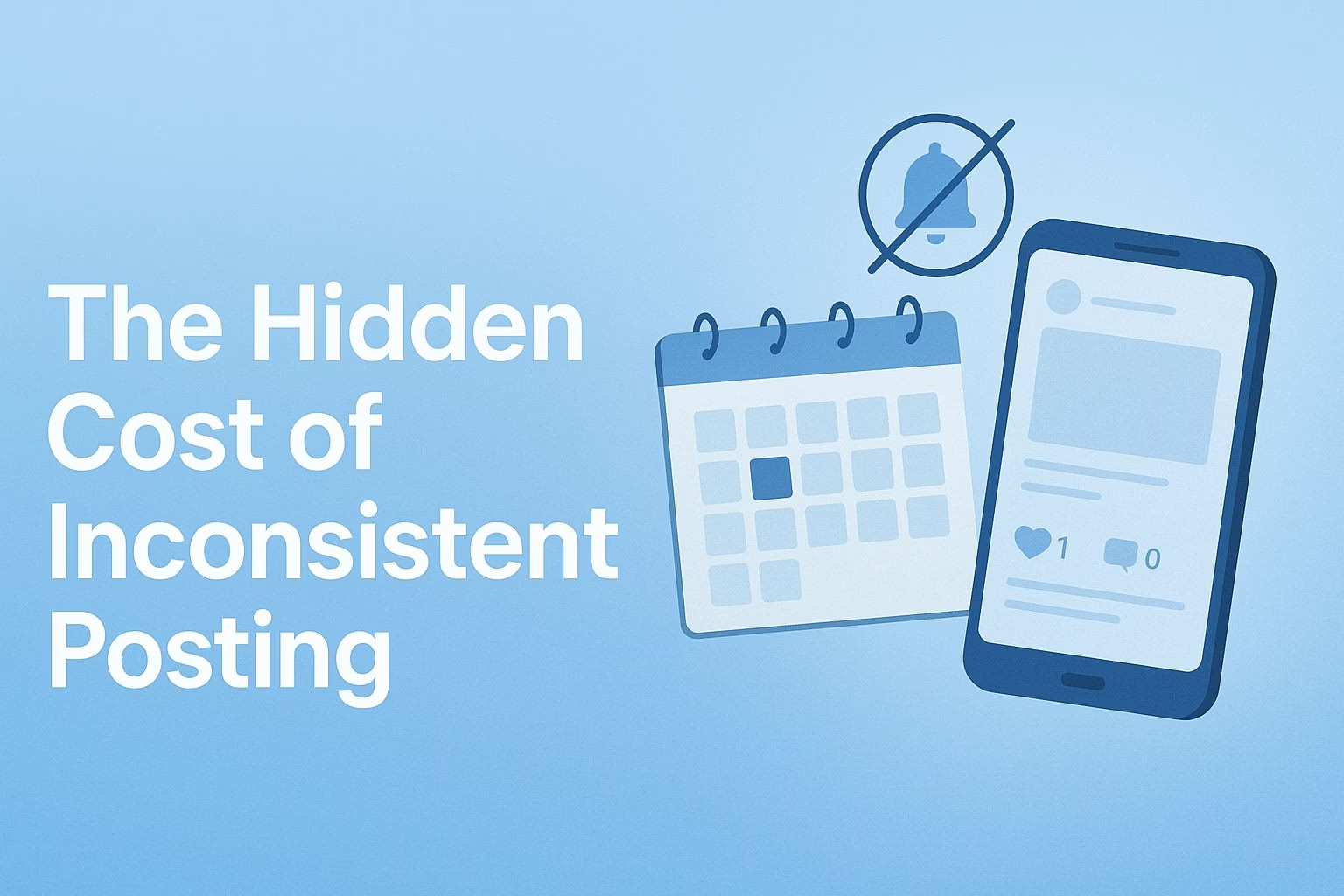The Hidden Cost of Inconsistent Posting on Social Media
Key Takeaways
- Inconsistent posting hurts reach, engagement, and audience trust.
- Algorithms reward accounts that show up regularly and predictably.
- The real cost of gaps is lost leads, slower growth, and weaker credibility.
- Planning, batching, and scheduling make consistency easier to maintain.
- Automation tools like Blaze Autopilot help sustain posting without adding pressure.
- Consistency builds trust and credibility that directly impact sales and growth.
- The smartest strategy is to create a system that works in the background while you focus on running your business.
I used to think posting whenever I had time was enough to keep my business visible online. As long as a few updates went out each week, it felt like I was doing my part.
What I didn’t realize at first was how much inconsistency was hurting me. Followers weren’t engaging, algorithms weren’t showing my content, and the gaps in posting made it seem like my brand had disappeared altogether.
The truth is that social media punishes inconsistency. Platforms are designed to reward accounts that show up regularly and deliver fresh content. When posting drops off, visibility shrinks. Even the people who already follow you stop seeing your updates as often. It’s not just a matter of missing one week—it creates a ripple effect that slows growth long after you start posting again.
For small businesses, this kind of inconsistency carries hidden costs. Lost reach, weaker trust, and fewer leads all add up. You don’t just lose engagement—you lose momentum, and rebuilding it takes more work than staying consistent in the first place.
In this article, I want to share the ways inconsistent posting drains your brand, what it really costs behind the scenes, and how I learned to fix the problem without spending endless hours creating content.
Consistency Matters More Than You Think
When I first started posting online, I underestimated how much the algorithm cared about frequency. I thought quality alone would carry me.
What I learned is that even the best post has a short lifespan if there is no consistent flow behind it. Platforms like Instagram, Facebook, and LinkedIn want to keep users engaged.
They push forward the accounts that show up daily or at least on a predictable schedule.
That consistency tells the algorithm that your account is active and worth promoting.
It also sends a signal to followers. People begin to expect your content at certain times, and that familiarity builds trust.
The opposite is also true. If you disappear for two weeks, followers lose interest, and the platform reduces your reach.
Consistency is not only about visibility. It creates compounding growth. Every post adds to the footprint of your brand. Over time, small efforts stack into real momentum.
Once that rhythm is disrupted, the compounding stops, and it takes much longer to recover than to maintain steady posting in the first place.
For me, realizing that consistency was more valuable than chasing one viral post completely changed how I approached content.
Growth became less about luck and more about showing up regularly.
The Real Costs of Dropping Off the Radar
Inconsistent posting does more than slow down growth. It has a direct impact on how people view your business.
When your content shows up sporadically, followers start to question whether you are reliable. That doubt can spread to how they see your products or services, even if you are excellent at what you do.
Leads are another hidden cost. Every missed post is a missed chance to reach someone who could have become a customer. I noticed this the hard way.
Weeks without updates meant fewer inquiries, less website traffic, and ultimately fewer sales. The silence on social media translated into silence in the business.
The most frustrating part is how hard it is to regain momentum. Algorithms do not reward you immediately for coming back. Instead, it can feel like starting from scratch.
Engagement is lower, reach is weaker, and the audience takes time to re-engage. The gap between posting consistently and posting inconsistently is much wider than it looks on the surface.
That hidden cost is what convinced me to treat consistency as a non-negotiable. The price of dropping off the radar was simply too high.
How to Stay Consistent Without Burning Out
I used to think the only way to stay consistent was to push harder. I would block off time late at night or on weekends just to get posts ready.
That worked for a while, but it was exhausting. Eventually, I realized that consistency cannot rely on willpower alone. It needs systems that make posting easier.
One approach that helped me was creating a content calendar. Planning a week or a month in advance took away the stress of last-minute posting.
Instead of scrambling for ideas each day, I knew exactly what was coming. The process made posting less of a burden and gave me space to focus on the business itself.
Batching content was another game-changer. Setting aside a few hours to write captions, design graphics, and schedule posts saved me far more time than trying to create content daily.
By grouping tasks together, I could create a consistent flow without burning out.
The key lesson was this: consistency comes from structure. Once the system is in place, posting regularly becomes a habit instead of a constant struggle.
The Smarter Way to Keep Posting Regularly
Even with planning and batching, I still ran into the problem of time. Running a business means priorities shift, and no matter how well I prepared, some weeks the calendar just fell apart.
That is when I started looking at automation differently.
Instead of just using tools to schedule posts, I explored solutions that could help with the entire process. That meant creating, scheduling, and even adapting content based on what worked best.
The goal was not to remove my voice but to lighten the workload so consistency did not depend on me always being available.
This is where AI-driven tools stood out. The ability to generate posts in my style and publish them across multiple platforms meant I could finally step back without losing my presence online.
Blaze Autopilot became part of that solution for me. It learns a brand’s voice, creates content, and keeps posting consistently while adjusting to audience response.
Letting it handle the flow, I stopped worrying about gaps in my posting schedule.
For the first time, I felt like consistency was possible without the pressure that usually comes with it.
Automation made it sustainable.
Consistency Builds Trust
Over time, I realized that consistency was not just about working with the algorithm. It was about building trust with the people who followed me.
Every time I showed up with fresh content, I was sending a signal that my business was active, reliable, and worth paying attention to. That repeated presence built familiarity, and familiarity turned into trust.
Inconsistent posting had the opposite effect. Long gaps gave the impression that my business was either struggling or too disorganized to keep up.
Even if that was not true, perception matters. Trust is fragile, and once it slips, it takes effort to earn back.
Consistency gave me more than reach; it gave me credibility. Followers who trust a brand are far more likely to engage, share, and eventually buy.
That trust starts with simply showing up.
Making Social Media Work for You
Social media can feel overwhelming when posting is treated like a constant chore. What I learned is that it works best when it becomes a system.
Planning ahead, batching content, and using smart tools to support the process turned inconsistency into momentum.
The hidden cost of dropping off is too high for any small business. Lost reach, weaker trust, and fewer leads all add up.
The good news is that staying consistent does not have to drain all your energy. With the right approach, it becomes sustainable.
For me, the shift happened when I stopped trying to do everything myself and started using automation as support. That balance gave me freedom while keeping my business visible.
Consistency became less of a struggle and more of a strength, and that made all the difference.

